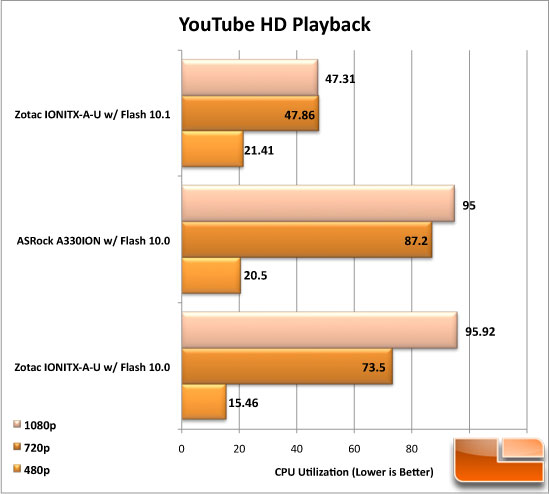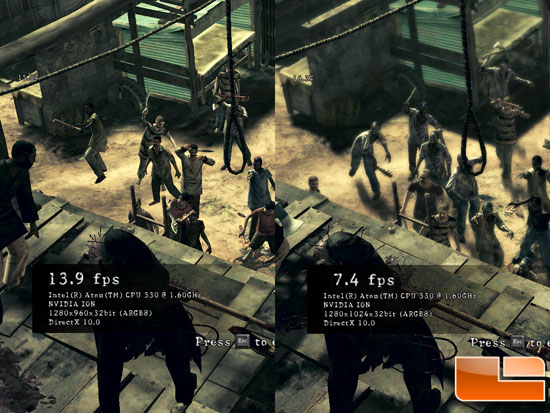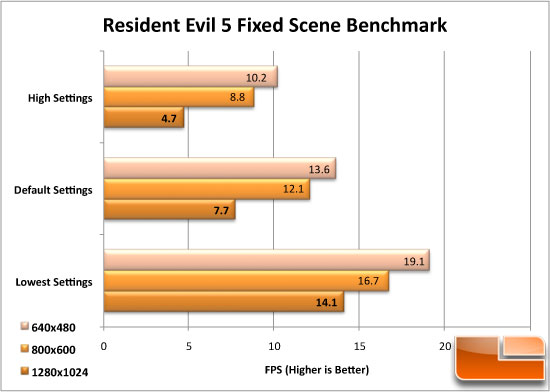ASRock A330ION Mini-ITX Motherboard Review
YouTube and Resident Evil 5
After the previous page’s grueling examination of hard numbers and science, it’s good to take a step back, breath a relaxing lungful of air, and just take the whole picture in. What do I mean when I say this? Well, numbers may be good for comparing a system to another one, but those numbers don’t necessarily mean anything in real life. Instead, we need to look at something with a little more substance and a bit more application. For instance, how does the ASRock A330ION do playing back YouTube videos in high definition? I mean, that’s the kind of thing that’s actually important — at least that’s what I’m hearing on the streets from the kids these days. So let’s do this!

To perform this test, we loaded a video on YouTube that was available in three different resolutions: standard definition, 720p, and full 1080p high definition. The video and more information about this particular type of test, in all its gory details, can be found in this review of
Adobe Flash 10.1. In that article, we compared the playback performance of a YouTube video comparing the current version of Adobe Flash 10.0 with a beta version of Flash 10.1. Well, in this test, we again used the most current version of Adobe Flash 10.0 (in Internet Explorer 8). Then we used perfmon, a performance monitoring application, to find the average CPU utilization of a minute of video playback.
In the above chart, the ASRock A330ION at stock speeds is compared to the Zotac IONITX-A-U when both are using Adobe Flash 10.0. As a reference to what the future may hold, however, we also included the Zotac IONITX-A-U benchmarks for the Flash 10.1 beta. What’s interesting here is that, despite the benchmarks on the last page showing the ASRock A330ION as the more powerful board, the raw CPU utilization of video playback spins another tale, a tale of curious mysteries. At each level of playback, the Zotac board performed better, rendering the video stream with fewer CPU utilization.
While this is an interesting outcome, it’s important to note the volatility of Flash, as Flash is dependent on several different factors, including video drivers, browser versions, operating system updates, the current phase of the moon, and whether or not butterflies are drawn to your nearest street lamp. So, while the difference in values make it seem the ASRock A330ION didn’t fare so well, ultimately the results were the same. Both boards played the videos back smoothly at 480p, while 720p playback dropped frames from time to time and concurrently using the computer for other tasks was a chore. Lastly, 1080p playback on both motherboards dropped a massive number of frames and brought the system to its knees to the point that Internet Explorer became unresponsive.
Subjectively, I call this one a tie.

Our next test was a run through of Resident Evil 5’s game benchmark. This benchmarking utility allows users to adjust video game settings to measure performance in order to maximize the playability of RE5. During the benchmarks, we adjusted the settings from the lowest possible to a reasonably high level (i.e., using motion blurring, 4x anti-aliasing, and high quality textures) and ran a fixed scene run-through to determine how the average FPS was affected. (A fixed scene run-through is one in which the scene plays back the same every time) The above screenshot shows the lowest possible settings on the left and the default settings on the right at 1280×1024 resolution, just to show the difference in rendering complexity.

(Note: The 640×480 resolution is a hidden option available only by modifying the configuration files manually. Some have reported stability issues at this resolution.)
Sadly, the ASRock A330ION did not fare well at higher resolutions or higher quality. In fact, it’s safe to say that RE5 is unplayable on this machine at 1280×1024, as even the lowest possible settings only had an average of 14 frames per second, easily low enough to make the motions jerky and game play a frustrating exercise of trying to relax. However, at lower resolutions, game play may have been considered smooth enough to frag some quasi-zombies in relative euphoria. Sure, it’s not like watching da Vinci paint Mona Lisa on a sunny day, but it would do in a pinch. Now, it’s unfair to think poorly of the ASRock A330ION just because it can’t deliver stunning rendered graphics; it wasn’t meant to play that latest generation of power-hungry video games. Instead, it was made to be small, be low-power, and support 1080p playback, and for those three things, it does extremely well. For what video games it can play, maybe it’s best to consider it a nice perk.
Who needs closure? This guy! See that last page for some final comments on the ASRock A330ION.

Comments are closed.